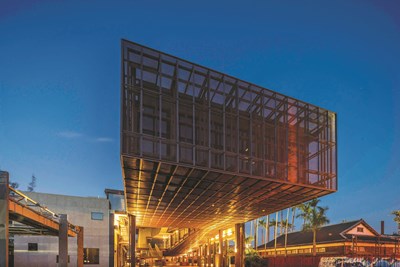
Recreatinga spacious urban site
Taichung Cultural and Creative Industries Park's R04 Building
Words by Chen Chia Yun
Translated by Anna Yang
Photos provided by Arctangent Architecture & Design
Chen, Chia-Yun
Writer Profile
Writer Chen Chia Yun majored in Architecture for her bachelor's degree and earned two master's degrees in Urban Design and Construction Management in London. She is used to applying both the left and right sides of her brain via creative design and business management, and practice as an architect while teaching and pursuing excellence in her architectural work. She applies passion and energy to both her life and profession, with the belief that beautiful architecture can bring comfort, and that the value of urban public space lies in resource sharing.
.R.O.C. Ministry of Examination Architect License Test Committee Member
.Owner at Point Architects and Planners
.Part-time lecturer at the Department of Architecture, National Cheng Kung University
The R04 building is located in the center of the park but is actually a bit closer to HeZuo Street. After modifications and additions, it has become a fusion of modern construction concepts and historic memories. The lobby leads one to a modern-style exhibition space, with a refurnished imported bottle-washing machine kept in a lobby corner. Due to military diplomacy in the past, many sizable machines were brought into the country by naval vessel in order to promote industrial development during many stages of history.
Many of the machines are stored on first floors in the park as public exhibits that showcase how these devices functioned in the past. The old buildings have been maintained and transformed from factories into a public spaces in order to bring history and culture back to life.
Architectural concepts and practices
The purpose for creating the R04 building was presenting a variety of exhibitions. The whole building is separated into bigger and smaller spaces, located to the back of the second floor and front of the third floor, with the floors joined by the open-spaced stairways providing overlooks and scenic slopes. Based on the traditional expression of patience, the designer applied a "ship in a bottle" concept to the building itself. As you walk inside, the longitudinal section corresponds to the flat surface, which feels like walking into a ship in a bottle.
The building was largely built with architectural concrete, steel and glass blocks, presented in their original state much like the concise and forceful meaning of a short sentence. The expression of the building demonstrates a pragmatic side to the modern architectural style, which also corresponds to the tone of light industries. The various repeating rectangular shapes are like the melody of a foundation, or even like words spoken with a tempo. As the shapes are all over the place, one can actually observe the correspondence of precisely drawn lines displayed on the outer walls. Big and small glass blocks correspond to the rectangular mast and stairways as the overall look of the design is accurately shown with logic.
It was previously challenging for the designer, prior to knowing the building's final purpose and in light of possible criticisms of his style. The definition of this construction case seemed to vary according to its environment and the city during early construction, but was then defined as a powerful vision of the future. As its purpose finally solidified, the characteristics of the space became the main foundation for creative redevelopment ideas.
Feeling the concrete in an open space
The R04 building sits about eight meters off the ground, like a floating object in the air, with the ground floor serving as a vacant space for pedestrians to freely pass through. The eye-catching ground floor has successfully been developed with its openness, and it is amazing to see a vacant space so filled and utilized with exhibition events, crowds, sounds and aromas. This creative open space within the old building is connected to the whole park.
The R04 building is a tan concrete structure built with light steel framing, with its color balancing and matching neighboring rooftops. The tan concrete is even more striking when surrounded by old buildings, as natural light seeks its way through gaps in between walls and illuminates the steel frames and netted walls. As you stand in the building, the hazy light generates a peaceful state of mind. You can also study the wooden walls, clapboard sidings, window frames and pipelines carefully as if these architectural materials and elements are telling a story about themselves. Thus, the colors and materials of R04 and the old buildings are closely connected in various ways.
The outer wall is a made with a translucent material surrounded with wire and metal frames, with the steel cable tightly connected to the back of the main concrete structure. The classy-looking walls are extended to become the whole ceiling top in a straight-forward and attractive design. The scenic sloping walls go along with the extensive walls, and the circulation in the space literally emphasizes the concrete space in the center of the whole building.
Pattern of movement
With the reorganization of the space, other characteristics are also revived. The designer believes that as time and culture develop, established designs from the past will be redefined and changed. The concepts of space, time and memory should be a relationship of movement, and quite different from older perceptions of conventional architecture styles.
The factory layout is simple as the building and its base have a static posture. Factories built in the past did not leave any public spaces for social events, but only a narrow public-use canopy provided by the entrance. Today architectural considerations of public usage imply the need to serve a broader variety of purposes. The direction signs by the entrance are intended to provide guidance, because architectural methods are becoming more complex. The complicated methods include hyphens in architecture to connect the central area to the building's outlying wings, breezeways and atrium area in order to closely join spaces.
The contrast between the gigantic floating concrete structure and traditional smaller-sized buildings is an interesting confrontation. The traditional layers are maintained, but the rooftop and most sections of the walls were torn down; with the stillness of the old space disappearing into the air. The floating object has become the new rooftop for the old building; the gap between walls allows natural light to pass through in order to smooth out the incongruous combination of new and old beings. The extensive winding wall of glass blocks covers up the entire space vertically, making the traditional layer more abstract. The added steel pole follows the designed outline system, but the architect purposefully misplaced the pole halfway down in order to distinguish the circulation movement from front to the back.
A commitment to the future
The R04 building is also known as the "Gallery of Vision", as the designer expects to engage it the developing of a future vision. Therefore, it can be manipulated by future owners with similar architectural concepts to make it a spotlight for local events. Clearly, the architectural team members have invested much time and efforts towards a shared ambition to create an ideal environment here.
There is an enormous distinction in creating a modern work from an existing small building using carefully molded metal and steel frames. Detailed parts of the structure are framed with unique iron nets and metal elements, which contrast the piled bulky bricks. From the perspective of space, architectural style, materials and design methods, this fusion of new and old explains a change in eras, while also inspiring unlimited possibilities that reach beyond the imagination.
As an engagement of the present and future, the designer hopes to create an unpredictable vision and freely-manageable style for the future. Due to the uncertainty of the environment and future users' concepts, the architect has carefully created the building space and aims to present the creativity and quality of the Gallery of Vision to the public. In such ways, the architect and his team are placing hope in their arrangements and the future usage of the building.
The spaces of old and new shift in the many settings of the building; the stairways joins the hyphens in architecture and the sloping walls with circulation, as every turning point seems to reveal more interesting stories about the building. The variable scenes of the floating space include the exhibition areas and the scenic slopes. Visitors walking through the building are an audience to the exhibitions, as well as a floating exhibited artwork if viewed from the outside. Other than fulfilling the industrial and daily needs, modern art also defines the characteristics of history. The philosophical issues of existence and non-existence are also analyzed and clarified in the spirit of the contemporary architectural stage.
Moving audience members behind the translucent glass walls are also a part of the exhibition show.
The floating exhibition space stands among the other old buildings as the birds-eye view from the sky.
R04 of Taichung Cultural and Creative Industries Park
Location: 362, FuXing Rd, Sec 3, South Dist, Taichung City
Date: January, 2015
Design: Arctangent Architecture & Design / Architects: Chia-Kai Yang
and Yu-Chin Chen
Architectural feature: The integrated architectural style of indoor
and outdoor spaces, the fun of wandering
between spaces, a city square fulfilling any
possibilities.
The R04 building utilizes simple construction materials to create neat and precise architecture.
〈Terminology〉
Narrative architecture: Making is not in the cultural processes of formation and interpretation, but in the dynamic network of spatial, social, intellectual and professional practices that embody and produce different kinds of social knowledge; it is also an opportunity for scenario writing.
The Spirit of Place: The formation of the material (ruins, building, route) and immaterial (memory, ritual, values), otherwise defined as the sense of belonging for a place.

 Facebook
Facebook
 Twitter
Twitter
 LINE
LINE